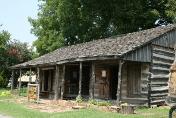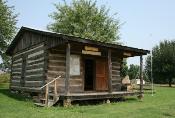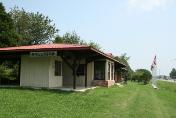

14 Flags Museum
The Lattimore Cabin was built
in around 1835 by Samuel
Lattimore, an early Cherokee
settler.
The Lattimore Cabin was built
in around 1835 by Samuel
Lattimore, an early Cherokee
settler.
ExploreSouthernHistory.com - 14 Flags Museum in Sallisaw, Oklahoma
ExploreSouthernHistory.com - 14 Flags Museum in Sallisaw, Oklahoma

| 14 Flags Museum The 14 Flags Museum in downtown Sallisaw is a unique and often overlooked Oklahoma treasure that preserves a number of historic buildings. |

Judge Faulkner's Cabin
Built during the 1840s, the
cabin has been enlarged to
represent a typical "double
pen" log house of frontier
days.
Built during the 1840s, the
cabin has been enlarged to
represent a typical "double
pen" log house of frontier
days.

Trail of Tears Exhibit
This cabin houses displays
explaining the Trail of Tears
and early Cherokee life in the
Sallisaw area.
This cabin houses displays
explaining the Trail of Tears
and early Cherokee life in the
Sallisaw area.


Sallisaw Depot
The historic train depot
reminds visitors of the days
when the railroad was the
main route of transportation in
Oklahoma.
The historic train depot
reminds visitors of the days
when the railroad was the
main route of transportation in
Oklahoma.
14 Flags Museum - Sallisaw, Oklahoma
Oklahoma under Fourteen Flags


Sallisaw's 14 Flags Museum takes its name
from the fact that Oklahoma has been the
home of at least fourteen different nations or
peoples.
Located along the railroad tracks in the
downtown area, the museum features a
fascinating collection of historic structures,
some of which date back to the time when
Cherokee settlers began arriving in the area
during the early 1830s. The interpretive park
also features an exhibit on the Trail of Tears.
The oldest structure at the 14 Flags Museum
is thought to be the Lattimore Cabin. Built by
Samuel Lattimore in around 1835, the little
log cabin provides a good view of the living
standards of the Cherokee settlers who
came to what is now Oklahoma ahead of the
main forced relocation of the nation on the
Trail of Tears.
The cabin originally stood two stories tall, but
even at its current reduced height it tells
much about life on the early frontier. The logs
of the walls were hand-hewn with axes and
adzes. The eastern wall is still pierced by a
loophole through which the inhabitants could
fire their rifles if they were attacked.
The Lattimore Cabin is a unique survivor of
the turbulent Civil War years in Oklahoma. It
was occupied at different times by both
Union and Confederate troops, but somehow
managed to survive when so many other
homes of those years were burned to the
ground.
Standing nearby is the Faulkner Cabin,
named for Judge Franklin Faulkner (who
signed his name as Franklin Falkner).
Another early settler of the Cherokee Nation,
Faulkner was the husband of a Cherokee
woman and as such was considered a full
member of the nation. He came west with his
family on the Trail of Tears and settled about
five miles north of Sallisaw.
The cabin, which has been enlarged since
its relocation to the museum to represent a
typical "double pen" log house," is thought to
have been built during the 1840s and is
another unique surviving structure of the
brutal Civil War years in Oklahoma.
More about early life in the Cherokee Nation
of today's Oklahoma can be learned at the
Trail of Tears exhibit, which is housed in
another cabin on the museum grounds. The
exhibit features displays and artifacts.
from the fact that Oklahoma has been the
home of at least fourteen different nations or
peoples.
Located along the railroad tracks in the
downtown area, the museum features a
fascinating collection of historic structures,
some of which date back to the time when
Cherokee settlers began arriving in the area
during the early 1830s. The interpretive park
also features an exhibit on the Trail of Tears.
The oldest structure at the 14 Flags Museum
is thought to be the Lattimore Cabin. Built by
Samuel Lattimore in around 1835, the little
log cabin provides a good view of the living
standards of the Cherokee settlers who
came to what is now Oklahoma ahead of the
main forced relocation of the nation on the
Trail of Tears.
The cabin originally stood two stories tall, but
even at its current reduced height it tells
much about life on the early frontier. The logs
of the walls were hand-hewn with axes and
adzes. The eastern wall is still pierced by a
loophole through which the inhabitants could
fire their rifles if they were attacked.
The Lattimore Cabin is a unique survivor of
the turbulent Civil War years in Oklahoma. It
was occupied at different times by both
Union and Confederate troops, but somehow
managed to survive when so many other
homes of those years were burned to the
ground.
Standing nearby is the Faulkner Cabin,
named for Judge Franklin Faulkner (who
signed his name as Franklin Falkner).
Another early settler of the Cherokee Nation,
Faulkner was the husband of a Cherokee
woman and as such was considered a full
member of the nation. He came west with his
family on the Trail of Tears and settled about
five miles north of Sallisaw.
The cabin, which has been enlarged since
its relocation to the museum to represent a
typical "double pen" log house," is thought to
have been built during the 1840s and is
another unique surviving structure of the
brutal Civil War years in Oklahoma.
More about early life in the Cherokee Nation
of today's Oklahoma can be learned at the
Trail of Tears exhibit, which is housed in
another cabin on the museum grounds. The
exhibit features displays and artifacts.
Also incorporated into the museum are the
old Sallisaw Train Depot, a reminder of the
days when railroads brought "high speed"
transportation to Oklahoma. Communities
like Sallisaw boomed when the railroad
arrived in the decades after the Civil War and
it became as vital a part of local life as paved
highways are to our generation.
The 14 Flags Museum is located in Sallisaw,
Oklahoma, in the downtown area just east of
the intersection of U.S. Highway 59 and U.S.
Highway 64 (also known as Business I-40
and East Cherokee Street). The outdoor
museum is open daily during daylight hours.
There is no admission fee to visit.
While in the Sallisaw area, a definite "do not
miss" spot is the nearby Sequoyah's Cabin
Historic Site which is located just 10 miles
from the 14 Flags Museum. The historic site
(which is closed on Mondays) preserves the
little log cabin where the inventor of the
Cherokee Alphabet lived after his relocation
to Oklahoma during the 1830s. Please click
here for more information.
old Sallisaw Train Depot, a reminder of the
days when railroads brought "high speed"
transportation to Oklahoma. Communities
like Sallisaw boomed when the railroad
arrived in the decades after the Civil War and
it became as vital a part of local life as paved
highways are to our generation.
The 14 Flags Museum is located in Sallisaw,
Oklahoma, in the downtown area just east of
the intersection of U.S. Highway 59 and U.S.
Highway 64 (also known as Business I-40
and East Cherokee Street). The outdoor
museum is open daily during daylight hours.
There is no admission fee to visit.
While in the Sallisaw area, a definite "do not
miss" spot is the nearby Sequoyah's Cabin
Historic Site which is located just 10 miles
from the 14 Flags Museum. The historic site
(which is closed on Mondays) preserves the
little log cabin where the inventor of the
Cherokee Alphabet lived after his relocation
to Oklahoma during the 1830s. Please click
here for more information.
Sequoyah's Cabin Historic Site
Tenkiller State Park
Heavener Runestone State Park
Robbers Cave State Park
Fort Smith National Historic Site
Historic Sites in Oklahoma
Explore other Southern Historic Sites
Tenkiller State Park
Heavener Runestone State Park
Robbers Cave State Park
Fort Smith National Historic Site
Historic Sites in Oklahoma
Explore other Southern Historic Sites




Custom Search
| Copyright 2011 by Dale Cox All rights reserved. |